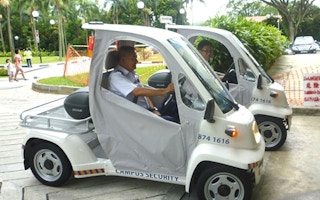Ten micro electric vehicles will be zipping around the National University of Singapore (NUS) campus over the next year as part of an urban transport study launched on Thursday.
Toyota Tsusho Asia Pacific (TTAP), a subsidiary of the Japanese Toyota Group, and NUS’s engineering department will study driver behaviour and travelling patterns within NUS’s Kent Ridge campus and the adjacent University Town over the next year.
TTAP executive vice president Yasuhiro Kakihara said at the launch that the single-seater electric vehicles - called COMS - could help reduce road traffic through car sharing schemes and by enabling easier access to public transportation.
“We feel that there is an urgent need to address issues related to traffic congestion and its impact on the environment in densely populated cities such as Singapore,” he added.
TTAP is considering setting up a self-service vehicle sharing scheme for use within local neighbourhoods such as West Jurong to help solve the “First and Last Mile” issue, he said, referring to the parts of commuter journeys not covered by public transportation.
Residents could use the vehicles for getting from their homes to the MRT or the local shopping centre, he noted.
About 2,000 of the COMS ply the public roads in Japan, where they were initially introduced a decade ago as pizza delivery vehicles. TTAP launched a second generation COMS vehicle on July 2nd in Japan that at ¥700,000 (just over S$11,000) is slightly cheaper than the original ¥1 million price tag.
In Japan, regulatory authorities classify COMS as motorcycles, but Singapore’s Land Transport Authority (LTA) has not yet designated a vehicle category for micro electric vehicles.
The vehicle category will have a deep impact on the viability of the COMS vehicles because it will determine the extra costs of owning the vehicles, which have an open market value of S$13,000 to S$15,000, said Mr Kakihara.
In addition to road tax and insurance, every vehicle purchased in Singapore requires a certificate of entitlement (COE), which costs from S$1,859 for motorcycles to S$90,501 for large cars.
The head of NUS’s electrical and computer engineering department, Professor Chua Kee Chaing, noted that the regulatory process would take time because it was an issue of human safety.
To use campus roads and up to 160 staff and students as drivers for the micro electric vehicle project, NUS had to obtain special approval from LTA.
The university also had to get approval from Singapore’s Energy Market Authority to install a system for charging the COMS’ lead-acid batteries, which can power the vehicles for 35 to 45 kilometres on an eight-hour charge.
NUS will track the traffic and charging patterns of the vehicles using a TTAP-developed remote monitoring system.
The study is part of a larger NUS research programme on sustainable transportation.
While TTAP’s COMS are user-operated, NUS researchers are also working on computer-operated – or autonomous – vehicles, said Professor Chua.
He predicted that a prototype – which would allow commuters to call a vehicle to drive itself to their location – would take about three years to develop.
The technology will not be the main challenge. It already exists, he noted, pointing out that making it affordable and reliable at higher speeds would be the difficult part.
“We will have to think through the non-technical issues such as regulation,” he added.
Other NUS transportation research includes intelligent traffic control and prediction, and power management systems for electric vehicles.
Of the joint project with TTAP, he said the most likely use for COMS in Singapore after the study would be as fleets for companies to use within strategic areas.
“This latest collaboration adds a new dimension in our work, giving NUS researchers the opportunity to look into the feasibility of personal movers as a sustainable mode of transport,” said Professor Chua.










